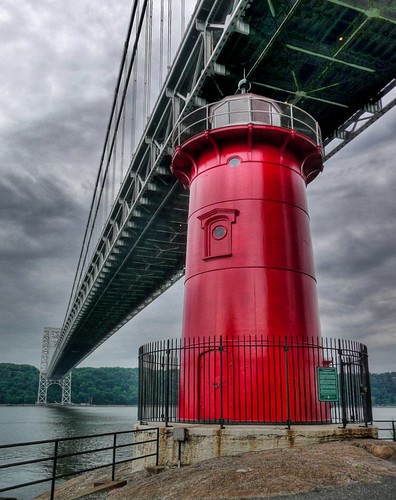
Little Red Lighthouse on a dark day
The Bailiwick of Jersey is a group of islands that includes Jersey as well as the uninhabited islands of Pierres de Lecq, Minquiers, Écréhous, and other islets. Along with the Bailiwick of Guernsey, the Bailiwick of Jersey forms the Channel Islands. And of the Channel Islands, Jersey is the largest and closest to France. The island’s capital is St. Helier.
Each year, many tourists visit this attractive and highly developed island. Jersey has a relaxed, friendly, and laidback reputation that makes it a great weekend or holiday escape. The island’s clean air, sparkling sea, and spectacular scenery of bays, rocky cliffs, and sandy shores are a far cry from the noise, pollution, and traffic of urban centers like London or Paris. But Jersey is also a cultural and historic destination with its museums, historic sites, and world-class attractions. And it also offers some of the world’s tastiest seafood dishes and specialties and restaurants that are internationally recognized.
History
Jersey has been inhabited for thousands of years, evidenced by the Neolithic tombs such as La Houge Bie that you’ll find on this island. William of Normandy conquered these islands in 1066, annexing them as part of his Anglo-Norman empire. In 1204, King John of England granted Jersey its own constitution after losing Normandy to the French, and the island has been self-governed ever since.
Things to Do
Today, tourism in Jersey is highly developed. The island offers every outdoor activity you can think of: swimming, fishing, kayaking, surfing, sailing, scuba diving, wakeboarding, water skiing, windsurfing, dolphin-watching, boating, skydiving, rappelling, archery, cycling, golfing, rock climbing, karting, and motor racing.
In addition, there are beaches and scenic views throughout the island along the coasts. The north coast features cliffs, caves, and beautiful bays including the panoramic Bouley Bay, the Bonne Nuit, Rozel, and Grève de Lecq. The west coast of the island features sandy shorelines, marshland habitats, grazing plains and fields, rock pools and shallows, and thick reed beds, especially around St Ouen’s Pond. The south coast is comprised of low-lying farmland, beautiful shorelines, and expansive bays. The interiors of the island are made up of woodland, grazing plains and pastures, and deep valleys. The east coast, on the other hand, is hillier and you’ll find castles and forts on the higher grounds.
Jersey also has a network of 50 miles of country lanes throughout the island known as the “Green Lanes” with speed limits of 15 miles per hour; priority of access is given to hikers, cyclists, and horse back riders. This path traverses through woods, fields, countryside, and stretches of coasts and is a great way to experience first-hand the idyllic charms of Jersey. In addition to “Green Lanes”, the island has another 350 miles of coastal and inland paths, promenades, and wood walkways that can be used by recreational pedestrians and cyclists.
While hiking, cycling, or driving around, there are beautiful and diverse wildlife and flora in Jersey to be observed. Many birds feed, dwell, and breed around the steep cliffs, rocky ledges, and burrows of the island’s coast like the puffin and the sand eel shoal. There are also a number of gulls, wildfowls, grey and ringed plovers, Brent geese, curlews, dunlins, sanderlings, Barn Owls, Short-toed Treecreepers, Dartford Warblers, Cirl Buntings, and Cetti’s Warblers. There are a few land species as well like the Green Lizard, Agile Frog, and the Red and Grey Squirrel.
Unique and interesting wildflowers also abound with more than 400 plant species that have been identified. Some of the rarer plants include the Dwarf Rush, Autumn Squill, Sand Crocus and the Yellow-horned Poppy. There are also countless woodland wild flowers and dune flowers, many of them found in Jersey’s nature reserves and conservations like L’Ouaisné Common and Portelet Common as well as in the island’s ecological sites like Les Blanches Banques, St Catherine’s Wood, La Landed du Ouest, and Les Landes.
Attractions
Jersey has a few must-see attractions. One of them is the Jersey War Tunnels. This is a museum that tells the story of the German occupation of the Channel Islands in WWII. The location of the museum is peculiar, eerie, and unforgettable – sheltered in an underground hospital that is built around a network of tunnels dug by slave laborers during the war.
The Jersey Zoo is another compelling attraction. It is a conservation of endangered species. The animals are not displayed in a traditional cage-like setting, but are rather empowered to roam around in the wooded environment within the confines of the zoo.


Comments